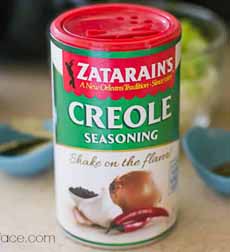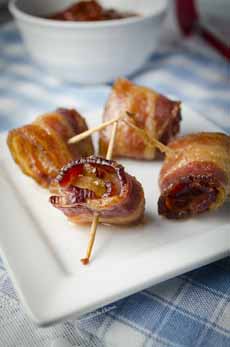RECIPE: Bacon-Wrapped Shrimp
|
May 10th is National Shrimp Day.
We could easily be happy with plate of boiled jumbo shrimp, a lemon wedge and a bit of seafood sauce. But this recipe for bacon-wrapped shrimp, sent to us by Zatarain’s, wins the nostalgia vote. It took us back decades to our parent’ cocktail parties, when bacon-wrapped shrimp and bacon-wrapped dates, or a rumkai—were de rigeur. Those with more basic tastes drank bourbon or scotch on the rocks. Few people were home mixologists Drinks of whiskey mixed with club soda or ginger ale were served on the rocks in highball (tall) or lowball (short, a.k.a. rocks) glasses. There was no American craft beer in those days, or even wine (except for gourmets who drank it as apéritifs and with meals at European restaurants). No one had even had a tequila drink, unless they’d been to Mexico. And there was no National Shrimp Day. But we have it all now. So, we’re turning on the broiler and making a pile of bacon-wrapped shrimp. Who’s in? RECIPE: ZESTY BACON WRAPPED SHRIMP In New Orleans, cooks add a Creole spin to this retro shrimp appetizer. You can prepare it in the morning and pop it in the oven later in the day. Find more shrimp at McCormick.com/Zatarains. You can have it as an appetizer, or make a dinner of it. Prep time is 10 minutes, cook time is 20 minutes. Ingredients For 8 Two-Piece Appetizer Servings |
[1] Bacon-wrapped shrimp from Zatarain’s. [2] Zatarain’s Creole Seasoning; photo courtesy Flour On My Face, who uses it in a Crockpot Jambalaya recipe. |
|
|
Preparation 1. PREHEAT the oven to 450°F. Line baking pan with foil and place flat baking rack in the pan. 2. WRAP each shrimp with 1 slice of bacon, lightly sprinkle with Creole seasoning and place the shrimp on the rack, seasoning side down. Sprinkle all the tops with the seasoning as well. Let stand 15 minutes 3. BAKE 15 to 20 minutes or until the bacon is crisp around the edges and the shrimp turn pink. Serve warm. |
||

|
RECIPE: CREOLE SEASONING If you don’t have Creole seasoning, it’s easy to make your own. This recipe makes much more than you need for the chicken salad, but you can cut it down or use the extra in other recipes, from eggs to burgers. 1. COMBINE all the spices in a bowl, and stir to combine. 2. STORE in an airtight container away from light and heat, but use as quickly as possible. Nineteenth-century Britain saw the rise in popularity of an appetizer called Angels On Horseback: skewered broiled oysters wrapped in bacon and “riding on slivers of toast.” It was also called Oysters And Bacon and yes, Pigs in Blankets, a recipe now known as mini sausages wrapped in pastry. “It’s an excellent lesson in how words, like recipes, change meaning over time,” says etymologist John Ayto in An A to Z of Food and Drink [source]. The recipe is first documented in the 1888 edition of Mrs. Beeton’s Book of Household Management. Devils On Horseback, a later recipe, substituted stuffed prunes for the oysters. Fast forward to the other side of the pond. Other foods began to be wrapped in bacon: scallops, shrimp, even stuffed olives and pineapple chunks. Another variation, bacon-wrapped chicken liver—rumaki—appeared. The first known reference of rumaki is on the 1941 menu of the Don the Beachcomber restaurant in Palm Springs, California. |
|
|
Rumaki were skewered water chestnuts and chicken livers, wrapped in bacon and marinated in soy sauce and ginger or brown sugar prior to broiling. The restaurant was founded in 1934, and was the beginning of the tiki craze in the U.S. Tiki restaurants—an American “interpretation” of Polynesian food and decor—featured a selection of different bites as faux-Hawaiian pupu (hors d’oeuvre). A flaming pupu platter of mixed “Polynesian” hors d’oeuvres was a sensation that trickled down to home preparations. So where’s the bacon-wrapped shrimp? So far, there’s a missing link. We did find a reference to shrimp skewered with a chestnut and a piece of green onion. It isn’t a stretch to think that someone added a bacon wrap…and that the recipe devolved to just the shrimp and bacon. Cajun and Creole are not the same, although people removed from Louisiana often use them without distinction. |
||






